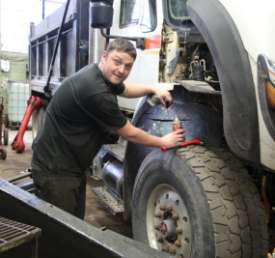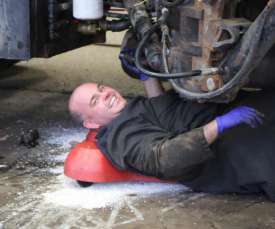
Jimmy Rhynes, fleet operations supervisor at the Queen’s County Government Garage on Riverside Drive
When plow drivers get the call to "get your V on", Jimmy Rhynes says it’s a signal that the storm was bad – but they’ve got it under control.
The V plow is only used to clear mountains of snow from completely blocked or empty roads.
“They’re saying it’s going to be a bad one, but we’re ready,” he said. “We’re just waiting for a skiff of snow to test everything.” As the temperature drops, the pace at the province’s government depots picks up. Crews have been busy since October 1 installing plow fronts on trucks, and during the second week of October they put the wings on. By the first of November everything is dressed and ready to go.
As the temperature drops, the pace at the province’s government depots picks up. Crews have been busy since October 1 installing plow fronts on trucks, and during the second week of October they put the wings on. By the first of November everything is dressed and ready to go.
In Queens County alone they have 55 machines to ready to tackle the winter -- everything from loader mount blowers and single axle trucks to tandem 4x4s, loaders, and graders.
After driving a plow for 25 Island winters, Rhynes knows snow removal. If you ask him, the more snow, the better.
Staff at the government depots work long hours during winter storms. Day shift workers stay later and night shift staff work into the wee morning hours to keep machines on the roads, and get the roads open for Islanders. Staff of the government garage play a key role in helping schools and others determine whether they should close during or following a storm. The depot gets custom weather forecasts twice a day from the department’s five weather stations located strategically around the Island, and plow drivers report on road conditions before dawn so the depot can update the school board.
Staff of the government garage play a key role in helping schools and others determine whether they should close during or following a storm. The depot gets custom weather forecasts twice a day from the department’s five weather stations located strategically around the Island, and plow drivers report on road conditions before dawn so the depot can update the school board.
The top priority is getting students to and from school safely and making sure the plows are able to escort ambulances – even when roads are closed.
As a proactive step, an ambulance is stationed in the depot when road closures are needed, so that staff can help EMS staff reach their destination faster.
What are Rhynes’ top tips for winter driving?
- Don’t pass the plows. Slow down and be patient.
- Avoid parking along roads when snow is predicted, so plow operators can effectively clear the street.
- Drive with four approved winter tires and watch for black (invisible) ice when temperatures are just under or just above freezing. Be especially careful on bridges, overpasses, and shaded areas.
- Allow extra driving time to get to your destination, and have a winter survival kit in your vehicle that includes a snow scraper, non-perishable food and water, wind-up flashlight, and extra clothes.


